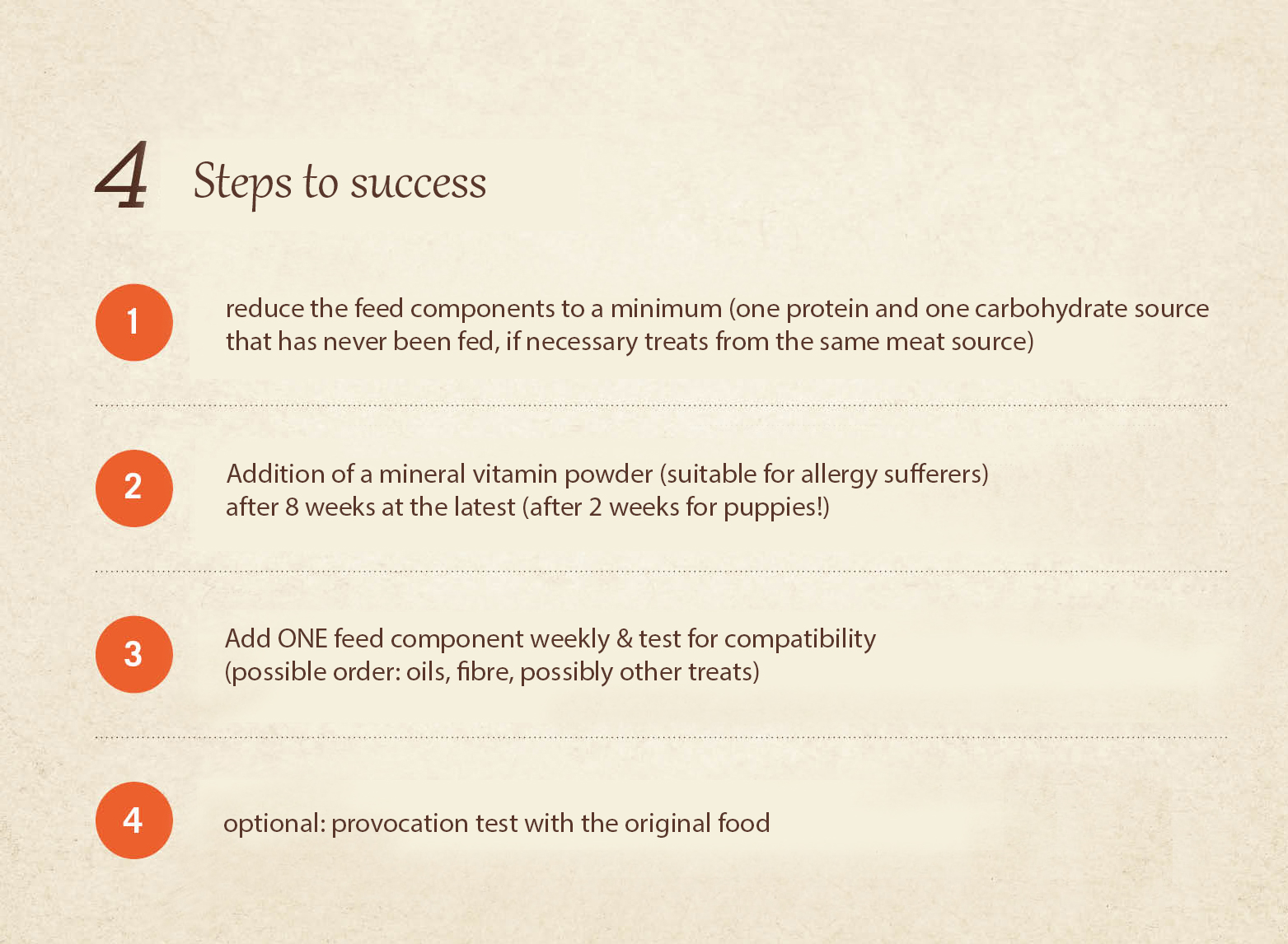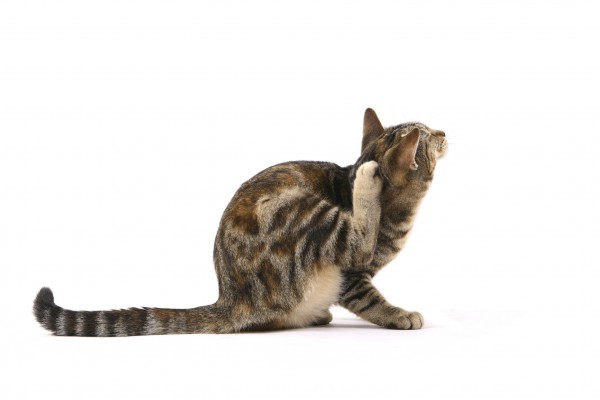If dogs or cats do not tolerate their food, this presents both the animal and the pet keeper with a number of problems. Your four-legged friend might suffer from pronounced reactions of the skin and the gastrointestinal tract. You will need patience, perseverance and consistency to find out and eliminate the underlying incompatible food component.
Find the cause
How do you find out what is really causing your pet's skin and intestinal problems? Apart from an actual intolerance of certain food components ("allergy" to feed), there are numerous other possibilities that cause symptoms in the skin and intestine.
For example, parasites on the skin or in the intestine can be the cause of similar symptoms. Your pet may be suffering fom Dysbacteria in the small or large intestine, reactions to environmental allergens (such as dust mites or pollen) or various hormonal diseases. One must not forget to take a look at the feed composition. This may already be an easily correctable cause of digestive problems.
For example, feeds rich in histamine such as beef, cheese, tomatoes & spinach can increase the permeability of the intestine, or moulds/bacteria in the feed can have toxicological effects. There are also feedstuffs that the organism cannot metabolise because it does not have the necessary enzymes or not enough of them (lactose in dairy products). In the case of BARF or cooked rations, a high offal content, gullet feeding, bone feeding or the administration of large quantities of legumes, cabbage varieties or even chewing articles can reduce digestibility and lead to problems. In addition, certain oils such as evening primrose or black cumin oil can have an irritating effect on the intestines of sensitive animals if given in excessive quantities. And, of course, any oil becomes rancid if stored for too long and can thus be the cause of problems. Feed additives such as herbs should also be closely examined.
For sensitive animals, the feeding technique should also be considered. Poor bowl hygiene, food that is too cold, too long a gap between meals and a sudden change of food can cause problems.
It is therefore essential to exclude "measurable" causes such as flea/worm infestation by means of a skin/fecal examination, hormonal diseases by means of a blood test, etc. and to analyse the current feed composition and feeding technique. The next step would be to eliminate possible causes before one can finally exclude or confirm the suspected diagnosis of feed intolerance by means of an exclusion diet.
Tense mood
An intolerance of certain food components manifests itself mainly in symptoms of the gastrointestinal tract and the skin.
The most obvious sign is often that the animals lick, bite and scratch themselves, regardless of the time of day or night, and are not deterred by a tasty meal, a cheerful game or a long walk. The underside of the body (armpits, belly, groin), the ears and the paws are primarily affected. However, some animals are also affected all over the body. The consequences are not absent: Bald patches, reddening and darkening of the skin appear on the hairy parts of the body, and in advanced cases secondary bacterial infections occur. Other alarming signs are repeated problems of the eyes, ears and anal sacs.
If the intestines are involved, the animals will defecate more often, which is typically covered with a "mucus coat".
Affected animals do not necessarily show skin and intestinal reactions at the same time. It is also possible that only one of the two organ systems is affected.
What to do
Once feed intolerance has been identified, there is only one promising course of action: The feed ingredient responsible for the reaction must be identified and eliminated from the ration. This can be done with the help of special feeding:
 The first step is to reduce the number of components fed to a minimum, i.e. feed a protein source previously unknown to the animal and a well-cooked, also unknown carbohydrate source (e.g. horsemeat & potatoes). The decisive factor is that the dog or cat has never before found the respective protein and carbohydrate source in the food bowl and therefore has not yet been able to develop an overreaction to it. For meat, horse, kangaroo, deer or ostrich are often used, and for carbohydrates, potatoes, sweet potatoes, millet or pseudo-cereals such as quinoa or amaranth. You can give treats at this stage if needed. It is very important to note that during the exclusion feeding, you may only give treats that come from the same animal species as the meat used in the preparation of the ration. In the case of a horse meat diet, for example, chewing articles made from dried horse meat would be suitable.
The first step is to reduce the number of components fed to a minimum, i.e. feed a protein source previously unknown to the animal and a well-cooked, also unknown carbohydrate source (e.g. horsemeat & potatoes). The decisive factor is that the dog or cat has never before found the respective protein and carbohydrate source in the food bowl and therefore has not yet been able to develop an overreaction to it. For meat, horse, kangaroo, deer or ostrich are often used, and for carbohydrates, potatoes, sweet potatoes, millet or pseudo-cereals such as quinoa or amaranth. You can give treats at this stage if needed. It is very important to note that during the exclusion feeding, you may only give treats that come from the same animal species as the meat used in the preparation of the ration. In the case of a horse meat diet, for example, chewing articles made from dried horse meat would be suitable.
In the second step, after 8 weeks at the latest (for puppies up to 12 months of age after 14 days!), a suitable feed supplement is selected to provide all the necessary minerals and vitamins. This must be suitable for allergy sufferers (e.g. Vitamin Optimix Sensitive for adult dogs, Vitamin Optimix Puppy & Junior for puppies or Vitamin Optimix Feline for cats & kittens).
In the third step, you can now - starting from this basic ration of meat, cooked carbohydrate source and mineral vitamin powder - test one further ration component each week with regard to the compatibility for your four-legged friend. If there is no reaction, the feed can be kept, but if symptoms reappear, it is better to do without this ingredient in the future.
As a sensible sequence in the 3rd step, it is recommended to complete the feeding (always with 1 week interval per feed):
- For a sufficient supply of essential fatty acids, first e.g. salmon oil, as it contains the omega-3 fatty acids EPA and DHA, which are essential for normal skin and coat function in dogs & cats.
- Follow this with a linoleic acid source such as safflower, corn germ, hemp OR sunflower oil. If your pet has mainly skin symptoms, it may make sense to supplement three times the amount of the necessary fatty acids.
- Feeding dietary fibre: You can supplement this with just one type of fruit or vegetable, or by adding appropriate tasteless powders (e.g. cellulose powder).
This way you can test out more ingredients week by week, i.e. you can test more fruits/vegetables & oils if the basic ration is well tolerated.
Another very important point that can be decisive for success: be sure to include your pet's surroundings! I.e. check out your family members and neighbours to make sure that your pet is not given any food other than his diet and also make sure that your dog does not get any other food when you go for a walk. This will falsify the results and may be the reason for failure.
By the way: An intolerance is only confirmed if the original food is offered again after all symptoms have subsided (step 4: provocation test) and the previously observed problems reappear within 14 days.

What happens next
With the correct composition of the feed and strict adherence to the above criteria, the symptoms should subside quickly. Since the cells of the intestinal mucosa have a high regenerative capacity, intestinal problems often improve after a few days. On the other hand, it sometimes takes several weeks for the inflammatory changes in the skin, including itching, to subside. If, however, there is no improvement after several weeks of special feeding, then the choice of meat and carbohydrate source should be reconsidered and possibly changed again and, if necessary, further causes such as an environmental allergy or previously undiscovered parasite infestation should be investigated together with the family veterinarian.
Are you unsure about what feed amounts to use? Or do you need help choosing the protein and carbohydrate source? We will be happy to help you with our individual Nutritional counselling to create a feeding plan that meets your needs. You can also find additional information in our recipe world.
We wish you a lot of stamina. Your pet will thank you for your patience, perseverance and consistency!
image credits:
Fotolia.com, #100484187, © adogslifephoto
Grafik Vorgehensweise © Futtermedicus (Papierhintergrund AdobeStock © saruntorn_ka #115679954)

